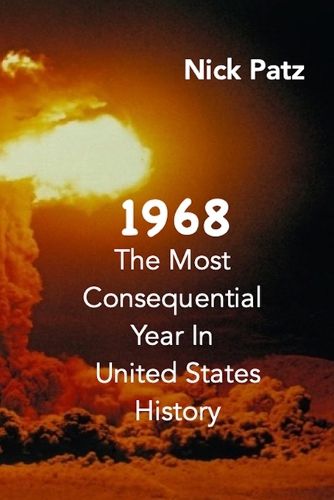Readings Newsletter
Become a Readings Member to make your shopping experience even easier.
Sign in or sign up for free!
You’re not far away from qualifying for FREE standard shipping within Australia
You’ve qualified for FREE standard shipping within Australia
The cart is loading…






This title is printed to order. This book may have been self-published. If so, we cannot guarantee the quality of the content. In the main most books will have gone through the editing process however some may not. We therefore suggest that you be aware of this before ordering this book. If in doubt check either the author or publisher’s details as we are unable to accept any returns unless they are faulty. Please contact us if you have any questions.
The year 1968 was a crucible for the United States. The country teetered on the edge of chaos. It began the Tet Offensive, a brutal campaign by the North Vietnamese that shattered the illusion of an easy victory in Vietnam. The war, once a distant murmur, was now impossible to ignore. Nearly 17,000 American soldiers would die in Vietnam that year, the highest toll of any phase of the war. In April, Martin Luther King Jr., the towering figure of the civil rights movement, was assassinated. King's death sent shockwaves through the nation, igniting race riots in cities across the country. June brought yet another tragedy. Robert F. Kennedy, who seemed poised to secure the Democratic nomination for President, was gunned down just moments after declaring victory in the California primary. The chaotic Democratic National Convention in Chicago that summer, had police clashing violently with protesters. America was watching the brutality unfold on television, Amidst this turmoil, Richard Nixon was elected President on November 5, 1968. Nixon had manipulated the Vietnam conflict to serve his own political ambitions. He ran against Hubert Humphrey, the Vice President who represented the failed policies of the Johnson administration, and George Wallace, the segregationist former governor of Alabama. It was a bitter, divisive election that reflected the deep fractures within American society. You will find that each of events of 1968 that are recounted here were not isolated moments but part of a broader narrative that spanned weeks, months, and even years. I have tried to keep these events in somewhat chronological order, but history, like life, is rarely so neat. I hope that by weaving together these threads, I can offer a clearer picture of why 1968 was such a consequential year-both for me and for the nation.
$9.00 standard shipping within Australia
FREE standard shipping within Australia for orders over $100.00
Express & International shipping calculated at checkout
This title is printed to order. This book may have been self-published. If so, we cannot guarantee the quality of the content. In the main most books will have gone through the editing process however some may not. We therefore suggest that you be aware of this before ordering this book. If in doubt check either the author or publisher’s details as we are unable to accept any returns unless they are faulty. Please contact us if you have any questions.
The year 1968 was a crucible for the United States. The country teetered on the edge of chaos. It began the Tet Offensive, a brutal campaign by the North Vietnamese that shattered the illusion of an easy victory in Vietnam. The war, once a distant murmur, was now impossible to ignore. Nearly 17,000 American soldiers would die in Vietnam that year, the highest toll of any phase of the war. In April, Martin Luther King Jr., the towering figure of the civil rights movement, was assassinated. King's death sent shockwaves through the nation, igniting race riots in cities across the country. June brought yet another tragedy. Robert F. Kennedy, who seemed poised to secure the Democratic nomination for President, was gunned down just moments after declaring victory in the California primary. The chaotic Democratic National Convention in Chicago that summer, had police clashing violently with protesters. America was watching the brutality unfold on television, Amidst this turmoil, Richard Nixon was elected President on November 5, 1968. Nixon had manipulated the Vietnam conflict to serve his own political ambitions. He ran against Hubert Humphrey, the Vice President who represented the failed policies of the Johnson administration, and George Wallace, the segregationist former governor of Alabama. It was a bitter, divisive election that reflected the deep fractures within American society. You will find that each of events of 1968 that are recounted here were not isolated moments but part of a broader narrative that spanned weeks, months, and even years. I have tried to keep these events in somewhat chronological order, but history, like life, is rarely so neat. I hope that by weaving together these threads, I can offer a clearer picture of why 1968 was such a consequential year-both for me and for the nation.